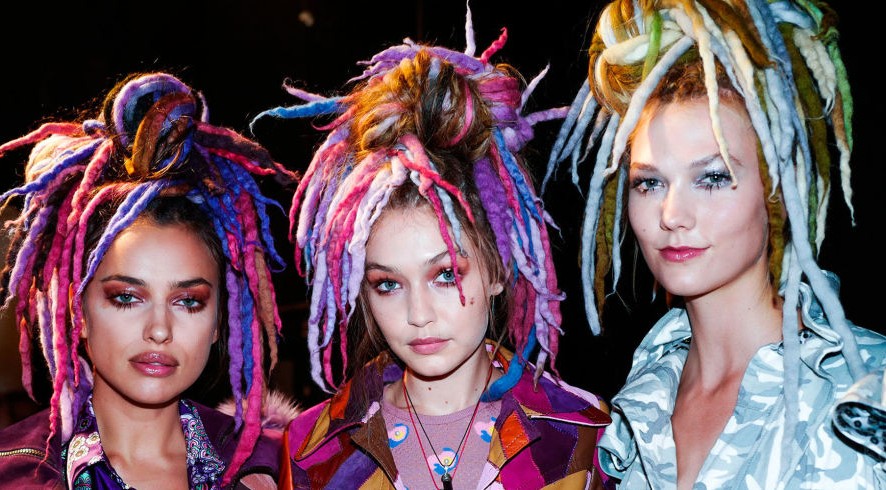Where is the line drawn between cultural appropriation and cultural appreciation in Marc Jacob’s and Ashish’s latest fashion shows?
Marc Jacobs in New York: Appropriation
The incorporation of a variety of cultural influences is something which makes fashion as we know it so diverse and interesting. Whilst diverse cultures should and are appreciated throughout creative practice, cultural appropriation is a highly deliberated topic which has once more been bought to the forefront of debate following recent fashion weeks.
Cultural appropriation is the adoption or use of elements of one culture by members of another culture. Known for encompassing a strong youth grunge influence, Marc Jacob was the fashion house at the forefront of criticism following his New York show. Complete with signature sky high platform boots, an army of models took to the runway in a show which combined Victorian inspired cuts with new age brights, influenced by the rave scene of years gone by. The catch to this otherwise innovative blend of influences was that Jacob’s models sported pastel coloured fake dreadlocks. The style originates back in Egypt over 3000 years ago and is exclusively associated with black culture. Whilst dreadlocks are often synonymous with freedom movements, it is evident that the use as an accessory by Marc Jacobs was an appropriation rather than an appreciation.
Whilst there is a completely different and standalone debate over the racial make-up of an average runway show, the sheer fact that the majority of Marc’s models were white insinuates that here, Marc was not praising nor appreciating the cultures synonymous with such a strong style. Marc failed to use his power in the industry as a platform for equality.
Instead, the show’s themes of frivolous femininity and disco-tech raves prompted questions regarding the true message of the show. The illegality often associated with the 90s rave scene is not to be ignored when regarding Marc’s message. By placing his top industry models in dreads, was he associating dreadlocks with wild behaviour and drug use? Considering how it was the show’s themes, rather than the clothes that made the headlines, could we determine that Marc and team carefully curated the show to prompt a press backlash for publicity following the growth of the black lives matter movement and the association dreads often have with political movements? The big names walking in the show such as current it girls Taylor Hill and Gigi Hadid, certainly ensured that press and social media attention to the show was rife.
Marc did however defend himself following the backlash, stating that “I don’t see colour, or race – I see people”. However, his comment was rendered useless as a defence when he further stated “funny how you don’t criticise women of colour for straightening their hair”. This is problematic and suggests that Marc’s use of dreadlocks was appropriation, not appreciation, given his blatant inability to acknowledge the inequality that still occurs between races. White people are not racially, nor culturally oppressed. When will major influencers such as Marc learn.

At the same time as London Mayor Sadiq Khan was tweeting #Londonisopen, Delhi born designer Ashish Gupta emerges onto his Bollywood inspired catwalk in a t-shirt clearly emblazoned with the word ‘immigrant’. His incredible celebration of multiculturalism and Indian culture in Britain comes after one of the biggest blows to the British fashion industry in recent history- Brexit. From this entrance the message of Ashish’s show is clear as the British Fashion Council’s creative exec Caroline Rush summarises: “People want to know if London feels different. We need to send them a clear message that London is open to outsiders”.
Appearing after the controversial show and comments of Marc Jacobs in New York a week before, Ashish shows exactly how cultural appreciation should be done. Unlike the line-up seen at Marc Jacobs, the models for Ashish were diverse in their ethnicity, with model Neelam Gill being the face of the show. When asked by Refinery29 about the controversy surrounding the use of dreadlocks on Marc Jacobs’ white models, Gupta said: “I think that fashion is meant to be aspirational, if you have all white girls on the runway what does that say about people’s aspirations? I think that’s quite shocking.”
 Another asset of the show in its strive for inclusivity was its gender fluidity as both male and female models walked the catwalk in a range of unisex pieces, the stand out accessory from one male model being a live python. The clothes themselves were an underlying blend of western silhouettes (mainly structured street style t shirts) layered with traditional South Asian pieces which forcefully highlighted the importance and beauty of multiculturalism.
Another asset of the show in its strive for inclusivity was its gender fluidity as both male and female models walked the catwalk in a range of unisex pieces, the stand out accessory from one male model being a live python. The clothes themselves were an underlying blend of western silhouettes (mainly structured street style t shirts) layered with traditional South Asian pieces which forcefully highlighted the importance and beauty of multiculturalism.
What Ashish demonstrated with his collection is the need for respect of origins and culture without hiding under the excuse of artistic or creative licence. The respect for cultural origins was evident in every aspect of the show from the sitars playing in the background to the traditional makeup and the Salwar Kameez and Sari garments. Brexit or not, Ashish’s collection proves Britain’s fashion industry to still be as inclusive as ever.
Victoria Copeland
Cover Image: Elle

